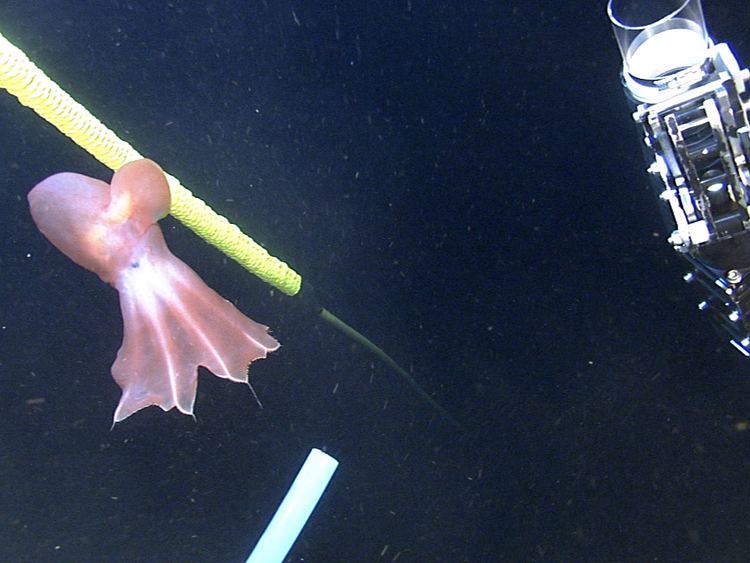Order Octopus | Species C. muelleri Rank Genus | |
 | ||
Similar Octopus, Cirrothauma murrayi, Cirrina, Stauroteuthis, Bathypolypus | ||
Cirroteuthis muelleri is one of the largest cirrate octopuses, growing to a length of 1.5 metres (4.9 ft). It is the only species of the genus Cirroteuthis.
Contents
Description
Cirroteuthis muelleri can reach a length of 1.5 m (4.9 ft). It is off white or pale purple, with the inner side of the arms and the webs being brownish-purple.
The head has well developed eyes with lenses. The upper and lower beaks are thin and relatively weak. The body is gelatinous and fragile. The arms are nearly equal in length. A pair of translucent webs joins the dorsal and ventral sides of the arms together and the webs terminate at a nodule. The first 7 or 8 suckers are cup-shaped and raised on thick stalks, numbers 2 and 3 being the largest. There are a further 30 or so smaller suckers with delicate stalks. Between the suckers are conspicuous cirri up to 19 mm (0.75 in) long. These are elongate, fleshy tendrils set along the sides of the oral surface of the arms, the longest being in the mid-arm region. Both the suckers and the cirri do not extend as far as the tip of the arm.
The fins are elliptical when viewed from the side. They are wide, and longer than the width of the head. The aperture of the mantle is narrow and the funnel is long. It has been nicknamed "Dumbo" after the cartoon elephant of that name, because its fins resemble large ears.
Distribution
Cirroteuthis muelleri is a deep sea species. It is found in cold seas in the boreal Arctic, the north Atlantic Ocean, the north Pacific Ocean and waters off New Zealand.
Habitat
Cirroteuthis muelleri is benthopelagic, meaning it is found swimming or drifting in the 10 m (33 ft) or so immediately above the sea bed. It is usually found at depths of over 2,000 m (6,600 ft). At these depths, practically no light penetrates, the temperature is about 4°C, and observation is only possible by submersible, which makes these octopuses difficult to collect. Their ecology and biology are little known, but they seem to be fairly common in the seas around Greenland.
Biology
In a study of Arctic cephalopods, three specimens of Cirroteuthis muelleri, all female, were caught near the ocean floor at 3,000–3,300 m (9,800–10,800 ft). The eggs were found to be large and were laid on the bottom, singly. The food is believed to consist mainly of small crustaceans.
